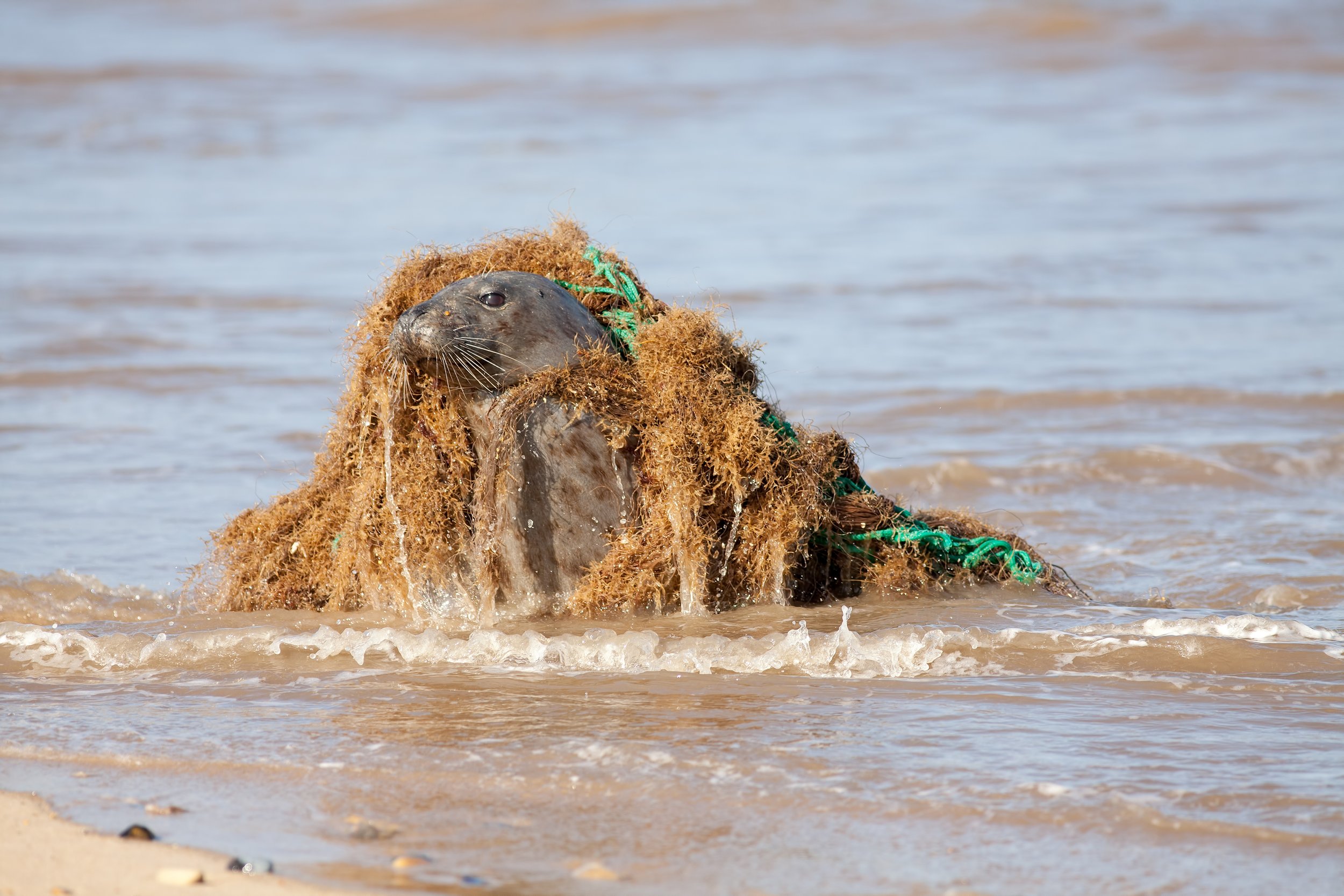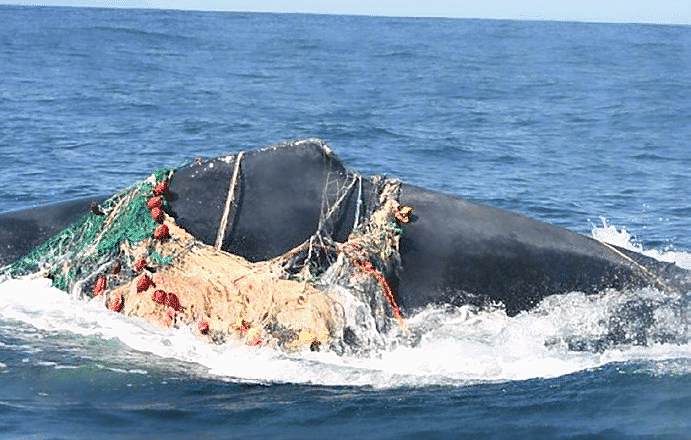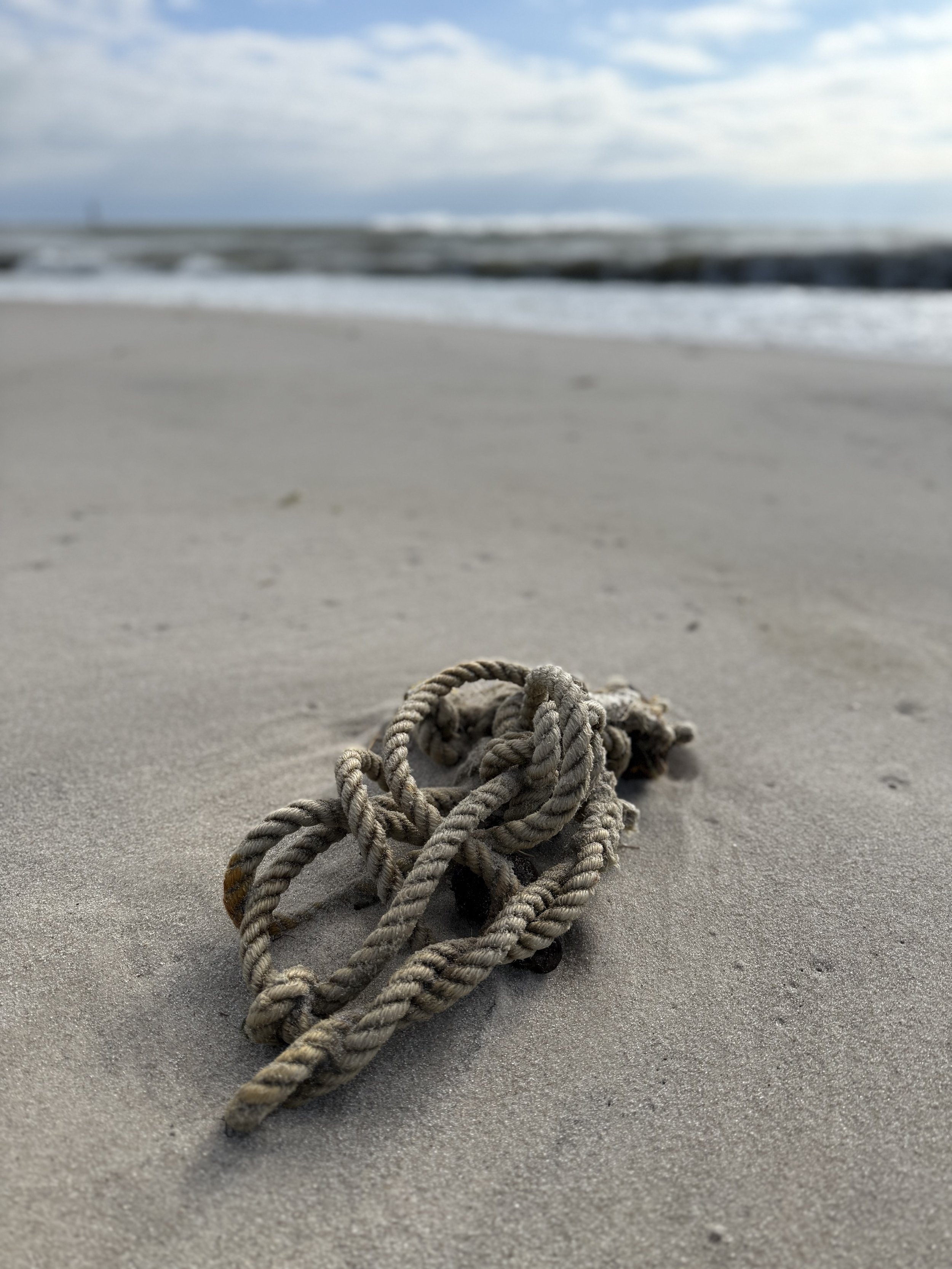
THE ATLANTIC OCEAN IS HAUNTED WITH GHOST NETS, CAGES, POTS, LINE & OTHER FISHING GEAR.
STOP GHOST FISHING NOW!
WHAT IS GHOST GEAR?
Ghost fishing occurs when derelict fishing gear, including nets, traps, and lines, that have been lost, discarded, or abandoned, continue to trap and kill marine animals.
While many organizations are raising awareness about the importance of sustainably sourced seafood (whatever that means?) and land-based plastic pollution, a major problem that continues to destroy and kill marine life across the world, including right here along the Jersey Shore is ghost fishing. It doesn’t get much attention by the media, but lost and abandoned fishing equipment such as nets, cages, lines and pots, often called “ghost gear,” trap and kill fish and and other sea life for many, many years until the gear is picked up and destroyed.
Overall, it is estimated that 5.7% of fishing nets, 8.6% of traps and pots, and 29% of fishing lines used globally are lost, abandoned, or otherwise discarded into the environment. All this ghost gear and other fisheries-related operations make up at least 10% of total ocean plastics. Yet, much of the plastic fishing debris (mostly nets and line) floating on the ocean’s surface accounts for as much as 70% (by weight).
While the above percentages seem low to the average person, World Animal Protection estimates that ghost gear kills over a hundred thousand seals, sea lions, and large whales every year. Further, when ingested, fishing equipment can cause gastrointestinal perforation, obstruction, sepsis, toxicity, and starvation in animals.
Lost fishing traps continue to kill animals. Any fishing gear that has been abandoned, lost or otherwise discarded is the most harmful form of debris.
Ghost gear can subsist in the water for hundreds of years, continuously harming animals, and destroying habitat. As the global demand for seafood rises, especially in overseas Euopeean and Asian markets, fishing operations continue to grow along the Jersey Shore and along the Atlantic Coast of the United States to increase the likelihood of ghost gear and its impacts.
Among the most deadly forms of ghost gear are gill nets, traps and lobster and crab pots. Gill nets are generally used to catch schooling pelagic species such as herring, mackerel, tuna, squid and sardines., but also other species including cod, hake, halibut, and sharks. The nets are large and can extend down 10 to 50 feet deep, and stretch up to 2 miles in length. These nets hang vertically and capture fish by entanglement. They travel thousands of miles, continuing to ensnare marine animals even when they are dormant on the seafloor. For example, a study using data from the US estimated that about 4,500 recovered ghost nets had killed “upwards of 2,500,000 marine invertebrates, 800,000 fish, and 20,000 marine birds” over the time the nets were derelict in the water.
Humpback whale (Megaptera novaeangliae) entangled in net and rope. Image credit: International Whaling Commission
Harbor seal (Phoca vitulina) tragically caught in the remains of a discarded fishing net.
According to World Animal Protection, approximately 640,000 tons of gear is left in our oceans each year due to storms, equipment malfunctions, or intentional abandonment. This gear traps, injures, mutilates and kills hundreds of thousands of whales, seals, turtles and birds annually.
It is estimated that lost or discarded fishing gear kills at least 136,000 seals, sea lions, and large whales annually, and around 650,000 marine animals, including sea turtles, crabs and sharks and other fish are killed annually due to ghost nets.
THE PROBLEM WITH GHOST GEAR?
GHOST GEAR IS ALL OVER THE PLACE!
Although there's no precise number for lobster traps lost along the New Jersey coast, researchers estimate that over 400 traps may be lost annually, with a 20% trap loss rate. This ghost fishing gear," can have a negative impact on the marine ecosystem of the Jersey Shore by attracting and trapping various marine life, including pregnant lobsters, crabs, and fish.
In the Mullica River-Great Bay Estuary in New Jersey, studies in this area have shown that high densities of derelict fishing gear are found in areas with high recreational and commercial activity. This poses a danger to northern diamondback terrapins, a species of special concern in the state.
In Long Island Sound, studies show an estimated 760,000 to 1.3 million ghost pots clutter the ocean bottom, posing a threat to crabs, lobsters and other wildlife.
In the Chesapeake Bay area, a team of researchers found that 3.3 million blue crabs are killed in derelict crab pots in the Chesapeake Bay, as well as more than 40 species of fish that are not the target of the traps.
In Maine, an estimated 30,000 to 600,000 lobster pots are lost annually, with some estimates suggesting as many as 10-25% of the 3 million pots set each year becoming "ghost gear.”
In the USA, it's estimated that 4,600 sea turtles die annually due to interactions with fishing gear, including ghost gear, a significant portion of which is attributed to entanglement and capture.
In the Gulf of St Lawrence in Canada, around 800 snow crab traps are estimated to be lost each year in the North Atlantic. (NOAA Chesapeake Bay Office, 2007).
IMPACTS OF GHOST GEAR!
Entanglement in fishing gear, including abandoned or lost "ghost gear," poses a significant threat to the critically endangered North Atlantic right whale population, with over 85% of the whales experiencing entanglement at least once in their lifetimes.
Ghost fishing can lead to the depletion of fish stocks and other marine populations, reducing biodiversity and impacting the overall health of marine ecosystems. For example, sharks and other marine animals can become entangled in ghost gear, leading to injuries, starvation, and death.
Ghost fishing gear can damage sensitive seafloor habitats like coral reefs and seagrass beds. Ghost gear impedes healthy coral growth by blocking the sun and breaking off or abrading coral heads.
Ghost gear can cause sediment build-up and damage vegetation, impacting sensitive habitats like mangroves and seagrass beds.
The continued capture of fish by ghost gear contributes to the depletion of fish populations, impacting fisheries and the livelihoods of people who depend on them.
Ghost gear, often made of plastic, can break down into microplastics, which are ingested by marine animals, potentially causing harm or death.
The breakdown of ocean plastic - including plastic fishing gear - can impact the health of marine organisms and ecosystems. Marine plastics are thought to transport invasive species and diseases across the ocean.
Ghost gear can pose a hazard to navigation, potentially damaging boats and endangering human lives.
JUVENILE HUMPBACK WHALE CAUGHT IN GHOST GEAR IN NEW JERSEY, 2018.
In July 2018, an approximately 30-foot-long juvenile whale was spotted in Raritan and Sandy Hook bays in New Jersey. The humpback whale had a piece of gill net, a type of netting used in commercial fishing, wrapped around its mouth forming a closed loop around its blowhole for several months. Members of the nonprofit Center for Coastal Studies' disentanglement team in Massachusetts arrived and used a custom-designed tool — a hook-shaped knife attached to a roughly 15-foot-long pole — to slice the piece of netting to free the whale.
GHOST GEAR IS A RECENT PROBLEM.
Before the 1960s, nets were commonly made from biodegradable hemp or cotton. Then came synthetic, degrade-resistant materials such as nylon. Nowadays nets can remain active in the water for hundreds of years. Lost or abandoned nets will continue to carry out their capture processes. Invisibly, below the surface of the water, this life-threatening gear will entangle and trap fish, sharks, seabirds, dolphins, sea turtles, and other aquatic animals to kill them. This is ghost fishing - a deadly and horrible phenomenon by commercial and industrial fishing practices that must stop!

SOLUTIONS
PEOPLE CREATED GHOST GEAR.
PEOPLE CAN SOLVE GHOST FISHING.
FISHERMEN NEED TO TAKE MORE RESPONSIBILITY!
According to the Marine Stewardship Council, the loss of pots and gill nets can be reduced by retrieving catch quickly and limiting the amount of time they are left underwater (‘soak time’). GPS mapping can also be used to avoid setting gear in areas with high risk of interaction with other vessels and mobile fishing gears.
Marking fishing gear to establish ownership is another effective preventative measure and incentivises the retrieval of lost gear. Identification can reduce gear conflict within or between fleets and helps identify illegal, unreported and unregulated fishing activities.
Good fisheries management is also key to preventing gear loss. This includes adequate on-board storage and crew trained to handle gear correctly and understand the impacts of ghost fishing.
RECYCLING
One way to prevent derelict gear from becoming “ghost gear” is to have fishermen return their worn-out nets and traps to their port for recycling instead of dumping it into the ocean. The port of Wellfleet, Mass., has collected 367,000 pounds of old gear from fishermen since 2008. Other high-volume collection points are Newport, Ore. (352,480 pounds); New Bedford, Mass. (285,000 pounds); and Point Judith, R.I. (242,000 pounds). Recycling programs like this need to expand to other fishing ports.
Buy-Back Program
The federal and state governments should create a buy-back program for marine debris. The program will have the goal of collecting fisheries-related marine litter (such as fishing nets, traps, lines, floats) deposited in the sea and on the sea bed. A buy-back project is especially designed to encourage fishermen to bring ashore litter collected, as part of their fishing activities.
Biodegradable fishing nets
A new study published in the journal Animal Conservation describes some promising tests done with biodegradable fishing nets. The researchers developed a net made of a blend of 82 percent polybutylene succinate (PBS) and 18 percent polybutylene adipate-co-terephthalate (PBAT) and compared its fishing efficiency with conventional nets. (If you can’t convince fishermen that these nets will do as good a job as regular, non-biodegradable nets, this is a pointless exercise.) During lab testing, the biodegradable nets had inferior theoretical performance to the regular nets (they had lower breaking strength and were stiffer), but during actual fishing they performed similarly to regular nylon monofilament nets and started to biodegrade after 24 months in seawater. This is only a first step. More testing needs to be done, and the biodegradable materials could no doubt be improved to better match the performance of conventional nets, but these tests were promising enough to show that this solution should be pursued further.
GHOST FISHING GEAR THAT WASHED ASHORE AT BARNEGAT LIGHT, NJ.
Abandoned and discarded mooring line found at Barnegat Light, NJ in February 2025. Mooring lines can kill wildlife by entangling marine mammals and birds, or by disturbing their habitats.
We Need to Increase Advocacy and Education!
Raise Awareness:
Educate the public about the issue of ghost fishing and its impact on marine ecosystems.
Support Policy Changes:
Advocate for stronger regulations and policies that address ghost fishing, including gear marking requirements, penalties for dumping, and incentives for recycling.
Collaboration:
Encourage collaboration between governments, fishing communities, environmental organizations, and industry stakeholders to develop and implement effective solutions.
Engage with Elected Officials:
Contact your local representatives and share your thoughts on the issue of ghost fishing and the need for action.
Pilot whale entangled








